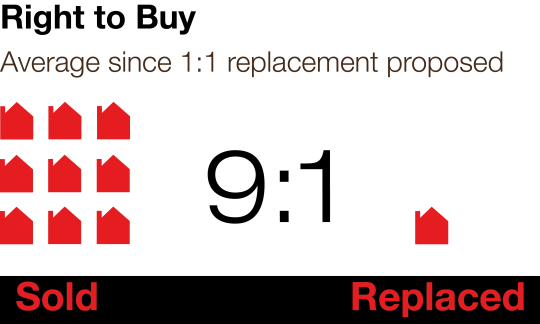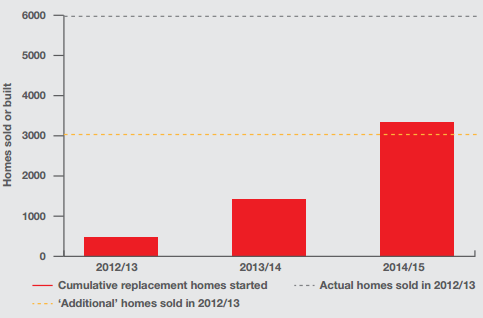This is the first of two posts about replacing homes that are sold through Right to Buy. This first part focusses on the existing replacement scheme – the second part looks at what a good replacement scheme would look like and can be read here.
We’ve long argued that giving social tenants the Right to Buy is fine in principle. It’s clearly great for some people, who get to benefit from generous discounts to buy their homes. We’ve also always been clear that all social homes sold like this must be replaced: otherwise, the stock of genuinely affordable homes will be continuously eroded.
Happily, the government seems to agree, and has made repeated promises of replacing homes since the Right to Buy was ‘reinvigorated’ in 2012. As they are now proposing to extend the Right to Buy further, to housing association tenants, whether this promise is being kept is very significant.
So, is the government replacing homes that are sold through the existing Right to Buy on a one-for-one basis?
The official stats are clear as crystal. For every nine homes that have been sold since April 2012, when the replacement scheme started, only one replacement scheme has only been started. (These are the relevant DCLG spreadsheets for council sales and replacement starts, lest there be any doubt.)
The Chartered Institute of Housing did some excellent analysis with the Local Government Association last year into the reasons why the current replacement scheme is falling short. While a lack of money was a major part of the reason, there were also other practical challenges that councils faced in replacing homes.
But in spite of the statistics and analysis, the government says that it is meeting its commitment. And this is how it justifies that claim:
- It says it’s only committed to replacing some of the homes one-for one, not all of them – the government made the one-for-one commitment when it increased the levels of Right to Buy discount. It says its commitment only applies to replacing homes that were sold as a result of that increase (i.e. the difference between the number of homes that were actually sold and the number that would have been sold anyway without the increase).
- It’s given itself three years to replace every home – there’s inevitably a lag between selling a home and building a replacement with the way the scheme is currently structured. The government has set councils and itself a three year deadline to build replacements.
Together, these points mean that the government is comparing the 3,337 replacements started in the three years up to the end of 2014/15 with the 3,054 ‘additional’ homes that were sold in the first year of the scheme, 2012/13. In total, 29,509 council homes were actually sold in the first three years of the scheme.
But even this claim needs some careful inspection. Think about it. A three year deadline doesn’t mean that you give yourself three whole years of replacements to count for just one year of sales. Otherwise for every extra year that homes are sold the deadline for building all the replacements moves back by three years. We’d be waiting until 2021 for even the homes that have already been sold to be replaced, and until 2036 for the homes sold off by the end of this parliament. If the scheme ran for another ten years we’d be waiting for another thirty for replacements.
So if the government is meeting its commitment, it is only managing it by pushing the deadline further into the future with every year that passes.
This doesn’t only matter for judging the success of the existing scheme. It also matters for the future. Because the government is currently proposing to extend the Right to Buy to all housing associations tenants, and to force councils to sell valuable council homes. And it is trying to calm fears that this will have a damaging effect by making exactly the same pledge – to replace every home that’s sold on a one-for-one basis.
How the current commitment to replace homes is working is therefore directly relevant for how we view any future pledge. If the government is blind to the flaws and failures of the existing scheme, the danger is that it will repeat them.


